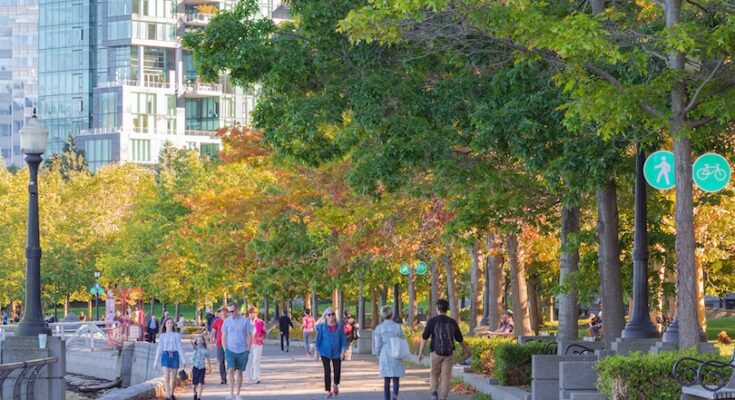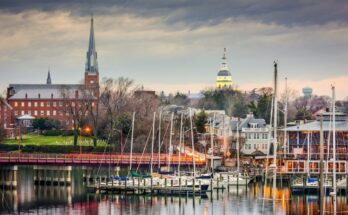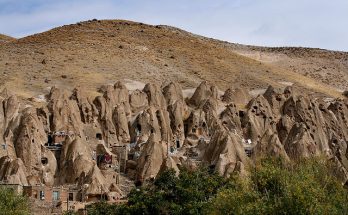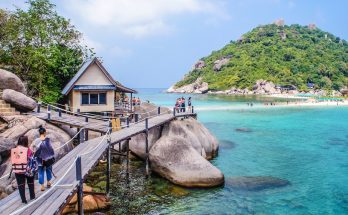Located in one of the most stunning spots imaginable, Vancouver is surrounded by sparkling shorelines and soaring snow-capped mountains. The largest city in Western Canada, it has a wealth of world-class museums and galleries to enjoy, aside from all its natural wonders.
One of the most popular destinations in the country, millions visit each year to see its sights and experience its thriving food and festival scenes. Summer is by far the best time to explore the cosmopolitan city as this is when the weather is warmest, the days are longest and the sun is shining.
To help you plan your trip, let’s take a look at what the climate, crowds and cultural events are like each month in the massive metropolis. We’ll also cover which periods are cheaper or more expensive to visit Vancouver.
In this post, we’ll cover:
What’s the Weather Like in Vancouver?
While Vancouver is blessed in terms of its spectacular scenery and nature, the same cannot be said for its climate. Often called ‘Raincouver’ or the ‘Wet Coast’, it sees a phenomenal amount of rain pour down between October and April.
It is only really the summer months of June, July and August that are relatively dry. This is when temperatures average a year-high of 20 to 22°C (68 to 71°F) and there are up to 16 hours of daylight each day.
In contrast, rain is almost guaranteed in the winter months though the city rarely sees much snow as temperatures are usually too mild. Many head to the nearby mountains to either ski or snowboard amidst all their pristine landscapes.
Best months to visit Vancouver

As conditions are best for ambling about the city and exploring the great outdoors, the vast majority of people visit Vancouver in summer. While lots of fun festivals are held and a very lively feel reigns everywhere, it is also peak tourist season when prices are highest.
Due to their blooming flowers and beautiful fall foliage, spring and autumn can also be great times to visit. Although a bit rainier, both April and May and September and October still see quite a few visitors head here. Just pack a light jacket and umbrella and you should be fine!
While December is much darker, colder and wetter, winter sports enthusiasts will love all the dramatic snowy mountains surrounding the city. Besides hitting the slopes, bright Christmas lights and decorations help create an enchanting atmosphere around town.
Vancouver in January

With low temperatures of around 6°C (43°F) and it raining a lot for 19 days on average, it is no wonder January is one of the quietest months of the year in Vancouver. That doesn’t stop thousands of locals and tourists from taking part in its Polar Bear Swim on New Year’s Day.
Some Christmas markets and decorations stay up with its Festival of Lights also continuing for the first week at VanDusen Botanical Garden. If it gets too cold, you can always warm up at the Harrison Hot Springs, east of the city.
While some people do come to ski or snowboard, hotel prices and flights are very affordable for the most part. Other than spending time in its museums, you can try its top restaurants during the Dine Out Vancouver Festival. The PuSh International Performing Arts Festival also puts on plenty of impressive shows in theatres around the city.
Vancouver in February

Although both festivals continue for the first few days of February, tourist numbers are even lower as the wet weather puts people off. While there are now 3 hours of sunshine and 10 of daylight a day, it still rains an awful lot. Some superb skiing, snowboarding and sledding can still be had though at Grouse Mountain or around Whistler.
Despite it being a couple of degrees warmer, you’re best off indoors admiring its outstanding art collections or trying out new eateries in Gastown. It is, however, well worth watching all the colorful parades and festivities held in Chinatown for the Lunar New Year. What’s more, its International Wine Festival has loads of wonderful reds, whites and roses to sample.
Vancouver in March

While its trees and flowers are beginning to bud, March is still the low season in Vancouver. Temperatures average around 11°C (52°F) with its rainy weather only relenting a bit. Hotels and flights are much cheaper now though than around both the Easter holidays and teeming summer months.
With an umbrella in hand, you can shop along Robson Street or explore all Granville Island’s art galleries and restaurants before the crowds arrive. As thousands of whales migrate off of the coast, you can also take unforgettable tours to see the majestic creatures. March is also usually the last month that you can ski at Seymour Mountain or Cypress Mountain.
Vancouver in April

As spring has really arrived and everywhere is a lush green, April is normally the start of the tourist season. Although it still rains for around 15 days on average, it is a little warmer with there also now being 6 hours of sunshine per day. It’s a wonderful time to stroll around the gorgeous Dr Sun Yat-Sen Garden or see the striking totem poles in Stanley Park.
Due to the Easter holidays, prices are now higher with the first few cruise ships also arriving at Canada Place. A lovely way to explore the scenic city is to take part in the Vancouver Sun Run. Aside from admiring all the pretty pink petals, numerous events are also held for its Cherry Blossom Festival.
Vancouver in May

Along with April, May is arguably one of the best months of the year to visit Vancouver. Less crowded than summer, its long, sunny days are perfect for exploring the center or enjoying some of its exciting outdoor activities. In addition, it rains a lot less with temperatures now averaging around 17°C (62°F). While accommodation is more expensive, airfares actually fall now that the Easter holidays are over.
Besides wandering around the blossoming VanDusen Botanical Garden, you can kayak about English Bay or hike in Mount Seymour Provincial Park. Many also cross the swaying Capilano Suspension Bridge, just north of town, as the spring thaw makes the raging river below look even more awe-inspiring. Before they get even busier, it’s worth taking trips to scenic spots like Bowen Island or the Butchart Gardens.
Vancouver in June

While June is, in theory, much better weatherwise than January, powerful rainstorms or cold spells are actually relatively common. This is referred to as ‘Juneuary’ by locals. Most years though, average temperatures finally reach 20°C (68°F) with there now being around 16 hours of daylight to walk around in.
As more people pour in, prices rise though are still way more affordable than July or August. There is a very vibrant feel about the place with lots of visitors taking trips to Squamish and Victoria or going whale watching. Plenty of fantastic events also go on such as its top-class International Jazz Festival.
On top of this, riveting performances of Shakespeare’s plays are put on from June through September as part of its annual Bard on the Beach Festival.
Vancouver in July

As many people have holidays, the sun is shining and weather is warmest, July is by far one of the most popular months to visit Vancouver. Averages of 22°C (71°F) and the 9 hours of sunshine each day are ideal for kayaking and paddleboarding or lounging about on Kitsilano Beach. While prices are higher, the lively ambience about Gastown and all the events going on make for a memorable visit.
Aside from exploring Stanley Park, you can play volleyball at Spanish Banks Beach or head up to the Vancouver Lookout. Countless concerts, parades and parties are also held for both Canada Day and Pride. The Vancouver Folk Music Festival has tons of top acts to catch while phenomenal fireworks displays take place for the Honda Celebration of Light.
Vancouver in August

August is the absolute peak season in Vancouver when all its hotels, restaurants and tourist attractions are at their busiest. While Robson Street and Canada Place do get quite crowded, you can always head to nearby mountains and forests if you want to avoid jostling for space in the centre. Hotel prices and airfares are both at their most expensive.
With it now only raining a bit for around 8 days on average, conditions are perfect for hiking and biking about its plentiful parks. Other than watching epic musicals at its Theater Under the Stars festival, you can attend exhibitions and music performances at the Harmony Arts Festival. Hundreds of other superb concerts, events and farmers’ markets are also organized all around town throughout August.
Vancouver in September

As most of the summer crowds have headed home but the weather is still warm and sunny, September is another of the best months to explore Vancouver. Prices are much cheaper but loads of exciting events are still going on. These include its fabulous Fringe Festival and the two week-long Vancouver Film Festival which continues into October.
While the days are a bit shorter, fiery autumnal foliage lights up the cosmopolitan city from mid-September onwards. Besides seeing all their gorgeous colors in Queen Elizabeth Park, you can learn about Canada’s artistic heritage at the BC Culture Days. Before the weather worsens, it’s worth taking trips to places like Bowen Island, Steveston and Victoria.
Vancouver in October

Although October is worse weatherwise, many still come to amble about the city and see its main sights like the Vancouver Aquarium and Gastown Steam Clock. Average temperatures drop to 14°C (57°F) with it also raining rather a lot for roughly 16 days of the month. If you take an umbrella, you should still be able to enjoy all of Stanley Park’s pretty colourful trees.
With fewer crowds around and the cruise ship season coming to an end, prices also fall with hotels and airfares being very reasonable. This is also the last chance to go whale watching or enjoy outdoor activities before the winter rains set in. You can always take part in parties and parades for Halloween or watch the Vancouver Canucks play.
Vancouver in November

As November is certainly one of the rainiest months of the year, the ‘Wet Coast’ is very quiet with barely anyone visiting. While both hotel and flight prices are much cheaper, its 19 days of rain make sightseeing a bit soggy. If you do visit, plan to spend most of your time indoors at its art galleries, aquarium or the Museum of Anthropology.
Although the fall foliage still looks good at the beginning of the month, there are now only 2 hours of sunshine and 9 of daylight per day in which to admire the autumnal colors. On the plus side, concerts, shows and events are held for the Eastside Culture Crawl and Chutzpah! Festival. As the holiday season approaches, twinkling lights and Christmas decorations are strung up all around the city.
Vancouver in December

While it rains an awful lot – 21 days on average – December sees more visitors return for the Christmas holidays and New Year’s Eve. As well as its festive markets and Festival of Lights, there are special seasonal plays, pantos and concerts to check out. Even its iconic Capilano Suspension Bridge is magically lit up with millions of twinkling lights!
As temperatures average just 6°C (43°F) and there are only about 2 hours of sunshine each day, you’ll still want to spend more time indoors. There is great skiing and snowboarding to be had though at Grouse Mountain, Mount Seymour and Whistler. Loads of concerts, parties and fireworks displays are then held all around Gastown and Canada Place to celebrate New Year’s Eve.



